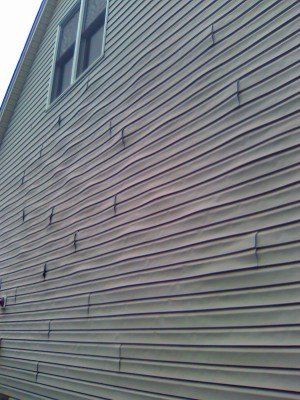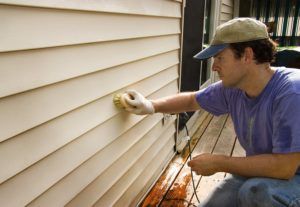
You may notice warps and waves in your vinyl siding after installation in Illinois. Why is your vinyl siding wavy and warping, and is this a problem? Wavy and warped siding generally indicates installation issues and can result in water damage, mold growth, and insect infestation.
Our team at Opal Enterprises can help you handle issues with wavy and warped siding. You can contact a Naperville siding contractor to schedule a professional assessment of the problem. Call or complete our online contact form to get started.
Improper Siding Installation Can Cause Warping
Improper installation represents the most common reason for warped and wavy siding. We see this problem when installation crews:
Nail Siding Down too Tightly
Vinyl contracts and needs room to shift and expand. Unfortunately, some installation crews nail vinyl panels down too tightly, resulting in the warping of vinyl siding.
You can check this issue quickly. Try to slide a piece of siding back and forth. It should move around a half-inch when you pull on it. The installation team probably nailed it down too tightly if you cannot budge the siding.
Improperly Place Nails
Installation technicians must place the nail in the center of the oval-shaped openings at the top of the siding planks. Improper placement of nails can cause vinyl siding issues, like buckling and warping.
Improperly Align Siding Panels
Vinyl siding contracts and expands with temperature changes. You may notice warping issues if contractors put the end of siding panels close to the trim surrounding your windows or corners of the building.
Misaligned panels also represent a common issue. These panels may bump and push against each other in intense heat, leading to warped boards over time.
We often check for this issue if only some of your siding shows warping or waves.

Only high-quality materials from trusted manufacturers when handling siding installation
What Other Issues Cause Vinyl Siding Panels to Warp?
Several issues besides improper installation may cause your siding to warp. You may experience this issue due to:
The Quality of Your Vinyl Siding
Poor quality siding will sometimes come already a little wavy. Be sure to do your product research before investing in a siding product. Vinyl siding that is very thin and flimsy is always a bad sign.
Poor quality vinyl siding is susceptible to warping, wavy appearance, and other flaws. Make sure the vinyl siding is certified by the Vinyl Siding Institute. Here is an official list of VSI-certified vinyl siding products.
The Color of Your Vinyl Panels
Did you pick a dark color for your siding? Color can contribute to issues with waves and warping. Darker shades of siding have a higher chance of warping because they absorb heat faster than light-colored siding.
You may want to stick to lighter colors to minimize this issue. Darker shades may prove especially problematic if your home gets a lot of direct sunlight.
Temperature Fluctuations
Temperature fluctuations throughout the year can cause your siding to contract and expand, potentially leading to warped vinyl siding. Installation issues usually contribute to warping problems caused by temperature changes.
Dirty Vinyl Siding
When you have wavy siding, it can give moisture and bugs the opportunity to sneak into the siding. If mold forms and bugs make nests within your siding, it can cause further deformations.
Mold can breed excess moisture and cause your home’s siding to deteriorate. That’s why engaging in a regular vinyl siding cleaning routine is essential. By cleaning your siding regularly, you can ensure that it stays in good condition.
Does Do-It-Yourself Installation Cause Warped Panels?
Some property owners decide to replace siding on their own. While this option may seem like a way to save money, it often leads to costly repairs as pieces of vinyl siding warp due to installation issues.
Our professional siding replacement team has the training, experience, and tools to quickly take care of the installation process. Our extensive experience means we understand the importance of nail placement and panel alignment.
You can contact a professional siding contractor in Des Plaines about any concerns you have in Chicago and surrounding areas.

Only high-quality materials from trusted manufacturers when handling siding installation
Can You Prevent Wavy and Warped Vinyl Siding?
We understand that you want to keep your siding looking great. Fortunately, you can take a few steps to minimize issues with warped and wavy siding. Make sure that you:
- Hire siding experts to prevent improper installation
- Handle warping at the first sign of trouble
- Consider adding reflective shades or changing your landscaping to reduce sun damage
If you’re considering renovating the exterior of your home, you can minimize the odds of warping by picking the right material. For example, fiber cement siding can handle extreme temperatures much better than vinyl and doesn’t warp.
Wood siding also resists warping but may have a higher initial cost and typically requires more maintenance work than vinyl and fiber cement siding options. We can discuss the correct type of siding for your home when you contact us for help.
Can You Fix Warped Vinyl Siding?
You cannot unwarp a piece of vinyl siding once the damage occurs. However, we recommend against leaving the problem unaddressed. Warped siding leaves your property exposed to damage from moisture, mold, rot, and insects.
You can minimize structural damage to your home by immediately contacting the professionals to determine if it’s time to replace your house siding.
Our team can quickly set up an appointment to visit your property and assess the damage to your siding. We may recommend replacing dark-colored siding or updating the look of your home with fiber cement siding from well-known manufacturers like James Hardie.
Speak to Us About Wavy and Warped Vinyl Siding
Why is your vinyl siding wavy and warping? Poor installation, temperature fluctuations, and issues with quality are common culprits for this issue. Our team at Opal Enterprises can address the problem and replace the damaged siding.
Find out more about your options by calling or filling out our online contact form.


